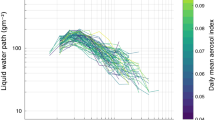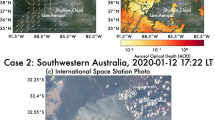Abstract
Aerosols alter cloud density and the radiative balance of the atmosphere. This leads to changes in cloud microphysics and atmospheric stability, which can either suppress or foster the development of clouds and precipitation. The net effect is largely unknown, but depends on meteorological conditions and aerosol properties. Here, we examine the long-term impact of aerosols on the vertical development of clouds and rainfall frequencies, using a 10-year dataset of aerosol, cloud and meteorological variables collected in the Southern Great Plains in the United States. We show that cloud-top height and thickness increase with aerosol concentration measured near the ground in mixed-phase clouds—which contain both liquid water and ice—that have a warm, low base. We attribute the effect, which is most significant in summer, to an aerosol-induced invigoration of upward winds. In contrast, we find no change in cloud-top height and precipitation with aerosol concentration in clouds with no ice or cool bases. We further show that precipitation frequency and rain rate are altered by aerosols. Rain increases with aerosol concentration in deep clouds that have a high liquid-water content, but declines in clouds that have a low liquid-water content. Simulations using a cloud-resolving model confirm these observations. Our findings provide unprecedented insights of the long-term net impacts of aerosols on clouds and precipitation.
This is a preview of subscription content, access via your institution
Access options
Subscription info for Japanese customers
We have a dedicated website for our Japanese customers. Please go to natureasia.com to subscribe to this journal.
Buy this article
- Purchase on SpringerLink
- Instant access to full article PDF
Prices may be subject to local taxes which are calculated during checkout






Similar content being viewed by others
References
Ramanathan, V., Crutzen, P. J., Kiehl, J. T. & Rosenfeld, D. Aerosols, climate, and the hydrological cycle. Science 294, 2119–2124 (2001).
Feingold, G., Jiang, H. & Harrington, J. Y. On smoke suppression of clouds in Amazonia. Geophys. Res. Lett. 32, L02804 (2005).
Squires, P. The microstructure and colloidal stability of warm clouds. I. The relation between structure and stability. Tellus 10, 256–271 (1958).
Albrecht, B. Aerosols, cloud microphysics, and fractional cloudiness. Science 245, 1227–1230 (1989).
Gunn, R. & Phillips, B. B. An experimental investigation of the effect of air pollution on the initiation of rain. J. Meteorol. 14, 272–280 (1957).
Rosenfeld, D. TRMM observed first direct evidence of smoke from forest fires inhibiting rainfall. Geophys. Res. Lett. 26, 3105–3108 (1999).
Andreae, M. O. et al. Smoking rain clouds over the Amazon. Science 303, 1337–1341 (2004).
Rosenfeld, D. et al. Flood or drought: How do aerosols affect precipitation? Science 321, 1309–1313 (2008).
Koren, I., Martins, J. V., Remer, L. A. & Afargan, H. Smoke invigoration versus inhibition of clouds over the Amazon. Science 321, 946–949 (2008).
Khain, A., Rosenfeld, D. & Pokrovsky, A. Aerosol impact on the dynamics and microphysics of deep convective clouds. Q. J. R. Meteorol. Soc. 131, 1–25 (2005).
Lee, S. S., Donner, L. J. & Penner, J. E. Thunderstorm and stratocumulus: How does their contrasting morphology affect their interactions with aerosols? Atmos. Chem. Phys. 10, 6819–6837 (2010).
Seifert, A. & Beheng, K. A two-moment cloud microphysics parameterization for mixed-phase clouds. Part II: Maritime vs. continental deep convective storms. Meteorol. Atmos. Phys. 92, 67–88 (2006).
Tao, W. K. et al. Role of atmospheric aerosol concentration on deep convective precipitation: Cloud-resolving model simulations. J. Geophys. Res. 112, D24S18 (2007).
Koren, I., Kaufman, Y. J., Rosenfeld, D., Remer, L. A. & Rudich, Y. Aerosol invigoration and restructuring of Atlantic convective clouds. Geophys. Res. Lett. 32, L14828 (2005).
Lin, J. C., Matsui, T., Pielke, R. A. Sr. & Kummerow, C. Effects of biomass-burning-derived aerosols on precipitation and clouds in the Amazon Basin: A satellite-based empirical study. J. Geophys. Res. 111, D19204 (2006).
Khain, A., BenMoshe, N. & Pokrovsky, A. Factors determining the impact of aerosols on surface precipitation from clouds: An attempt at classification. J. Atmos. Sci. 65, 1721–1748 (2008).
Fan, J. et al. Dominant role by vertical wind shear in regulating aerosol effects on deep convective clouds. J. Geophys. Res. 114, D22206 (2009).
Radke, L. F., Coakley, J. A. & King, M. D. Direct and remote sensing observations of the effects of ships on clouds. J. Appl. Meteorol. 246, 1146–1149 (1989).
Stokes, G. M. & Schwartz, S. E. The Atmospheric Radiation Measurement (ARM) program: Programmatic background and design of the cloud and radiation testbed. Bull. Am. Meteorol. Soc. 75, 1201–1221 (1994).
Ackerman, T. & Stokes, G. The atmospheric radiation measurement program. Phys. Today 56, 38–45 (January, 2003).
Liljegren, J. C. Paper presented at Fifth Symposium on Global Climate Change Studies. Nashville, TN, 25–28 Jan (1994).
Clothiaux, E. E. et al. Objective determination of cloud heights and radar reflectivities using a combination of active remote sensors at the ARM CART sites. J. Appl. Meteorol. 39, 645–665 (2000).
Andreae, M. O. Correlation between cloud condensation nuclei concentration and aerosol optical thickness in remote and polluted regions. Atmos. Chem. Phys. 9, 543–556 (2009).
Xie, S., Cederwall, R. T. & Zhang, M. Developing long-term single-column model/cloud system–resolving model forcing data using numerical weather prediction products constrained by surface and top of the atmosphere observations. J. Geophys. Res 109, D01104 (2004).
Qian, Y. et al. Heavy pollution suppresses light rain in China: Observations and modeling. J. Geophys. Res. 114, D00K02 (2009).
Khain, A., Rosenfeld, D., Pokrovskya, A., Blahakb, U. & Ryzhkovc, A. The role of CCN in precipitation and hail in a mid-latitude storm as seen in simulations using a spectral (bin) microphysics model in a 2D dynamic frame. Atmos. Res. 99, 129–146 (2011).
Klein, S. A. & Hartmann, D. L. The seasonal cycle of low stratiform clouds. J. Clim. 6, 1587–1606 (1993).
Lee, S. S., Donner, L. J., Phillips, V. T. J. & Ming, Y. The dependence of aerosol effects on clouds and precipitation on cloud-system organization, shear and stability. J. Geophys. Res. 113, D16202 (2008).
Bell, T. L. et al. Midweek increase in U.S. summer rain and storm heights suggests air pollution invigorates rainstorms. J. Geophys. Res. 113, D02209 (2008).
Grimm, A. M. & Silva Dias, P. L. Analysis of tropical–extratropical interactions with influence functions of a barotropic model. J. Atmos. Sci. 52, 3538–3555 (1995).
Koren, I., Remer, L. A, Altaratz, O., Martins, J. V. & Davidi, A. Aerosol-induced changes of convective cloud anvils produce strong climate warming. Atmos. Chem. Phys. 10, 5001–5010 (2010).
Khain, A. P. Notes on state-of-the-art investigations of aerosol effects on precipitation: A critical review. Environ. Res. Lett 4, 015004 (2009).
Stevens, B. & Feingold, G. Untangling aerosol effects on clouds and precipitation in a buffered system. Nature 461, 607–613 (2009).
Lee, S. S. & Feingold, G. Precipitating cloud-system response to aerosol perturbations. Geophys. Res. Lett. 37, L23806 (2010).
Li, Z. et al. Preface to special section: Overview of the East Asian Study of Tropospheric Aerosols: An International Regional Experiment (EAST-AIRE). J. Geophys. Res. D22S00 (2007).
Li, Z. et al. East Asian Studies of Tropospheric Aerosols and their Impact on Regional Climate (EAST-AIRC): An overview. J. Geophys. Res. 116, D00K34 (2011).
Crutzen, P. & Ramanathan, V. The Indian Ocean Experiment: Foreword. INDOEX Special Issue. J. Geophys. Res. 106, 28369–28371 (2001).
Niu, F. & Li, Z. Cloud invigoration and suppression by aerosols over the tropical region based on satellite observations. Atmos. Chem. Phy. Dis. http://dx.doi.org/10.5194/acpd-11-5003-2011 (2011)(under revision).
Skamarock, W. C. et al. A description of the advanced research WRF version 2 NCAR Tech. Note NCAR/TN-468+STR (National Center for Atmospheric Research, 2005).
Khain, A. P. et al. Simulation of effects of atmospheric aerosols on deep turbulent convective clouds using a spectral microphysics mixed-phase cumulus cloud model. Part I: Model description and possible applications. J. Atmos. Sci. 61, 2963–2982 (2004).
Fan, J., Ovtchinnikov, M., Comstock, J., McFarlane, S. & Khain, A. Ice formation in Arctic mixed-phase clouds: Insights from a 3-D cloud-resolving model with size-resolved aerosol and cloud microphysics. J. Geophys. Res. 114, D04205 (2009).
Morrison, H., Curry, J. A. & Khvorostyanov, V. I. A New double-moment microphysics parameterization for application in cloud and climate models. Part I: Description. J. Atmos. Sci. 62, 1665–1677 (2005).
Acknowledgements
The investigation would not be possible without the ARM measurements of the US Department of Energy, which also funds all investigators under its Atmospheric System Research programme. Z.L. was also supported by National Aeronautics and Space Administration (NASA) (NNX08AH71G), the National Science Foundation (NSF) (AGS1118325), and the Ministry of Science and Technology of China (2012CB955400, 2006CB403706).
Author information
Authors and Affiliations
Contributions
Z.L. initiated the project, led the study and wrote the manuscript. F.N. carried out data analyses, prepared the figures and documented the study. J.F. conducted model simulations. D.R. and Y.L. participated in science discussions and suggested analyses. Y.D. helped generate some supplementary figures.
Corresponding author
Ethics declarations
Competing interests
The authors declare no competing financial interests.
Supplementary information
Supplementary Information
Supplementary Information (PDF 843 kb)
Rights and permissions
About this article
Cite this article
Li, Z., Niu, F., Fan, J. et al. Long-term impacts of aerosols on the vertical development of clouds and precipitation. Nature Geosci 4, 888–894 (2011). https://doi.org/10.1038/ngeo1313
Received:
Accepted:
Published:
Issue Date:
DOI: https://doi.org/10.1038/ngeo1313



